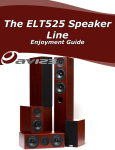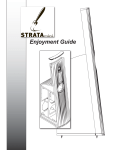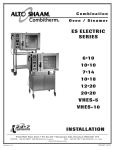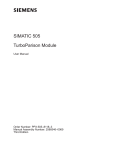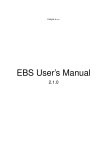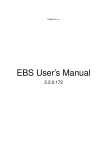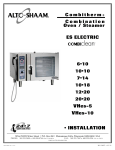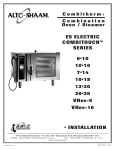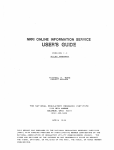Download AV123 x-sub Specifications
Transcript
x-series Enjoyment Guide Table of Contents Thank You for your x-series purchase 3 Safety Precautions 4 Unpacking and Product Registration 5 Features and Descriptions 6 Speaker Placement Considerations 8 Inventory Limited Warranty Coverage x-ls 2-Way Monitors x-cs 2-Way D’Appolito Monitors x-sub Powered Subwoofer x-sls 2-Way Towers x-mtm 2-Way D’Appolito Towers x-pls 3-Way D’Appolito Towers w/Powered Sub Front (Left and Right) Speaker Placement Center Channel Speaker Placement Surround Speaker Placement Subwoofer Placement Considerations 5 5 6 6 6 7 7 7 8 10 10 11 Speaker Placement Alternatives 13 Connections 15 Calibration 17 Technical Specifications 20 Limited Warranty and Return Policies 22 User Notes 23 Tower Speakers Shelf Mounting Stand Mounting Wall Mounting Left/Right Connections Center Channel Connections x-sub or x-pls Subwoofer Connections Wiring for Correct Polarity SPL Measurements x-sub/x-pls Crossover and Phase Adjustments Caring for your x-series speakers Service Assistance for AV123 x-series speakers 13 13 14 14 15 15 15 16 17 18 19 22 Thank You for your x-series purchase Dear Home Entertainment Enthusiast, At AV123, our absolute highest priority begins and ends with you, the customer. As our valued customer, you can rest assured that if you’re not 100% satisfied with your purchase within 30 days from your original receipt date, you may return your product(s) for a prompt refund in full (excluding shipping charges) with no explanation necessary. Coupled with the expert advice on our website and through our trained advisors, there is simply not a safer way or place to buy today. Mark with his pride and joy, Granddaughter Gracie, after her performance in the Nutcracker Ballet We make every effort to make sure your home entertainment needs are met with the great products and unbeatable service we offer every single day. Not only do we give you the tools and the resources to fully evaluate your purchase before your order is placed, we back this up after the fact by allowing you a full month to audition our products in your own home before your final decision is made. AV123 simply does not engage in misleading and high-pressure sales tactics. In the long run, we know it’s not the way either one of us wants to do business. We want customers for a lifetime. With the x-series speakers, we’ve taken steps to provide exceptional value for your dollar. There’s the 2-way x-ls monitors featuring a curvelinear long throw woofer in a vented enclosure and an exceptionally sweet sounding fabric dome tweeter. The tower version of this (the x-sls) offers the same configuration in a tower design. The x-cs 2way D’Appolito monitors are optimized for horizontal or vertical mounting orientation, so they are a perfect companion center channel to go along with x-ls monitors, xsls towers, or function as L/C/R monitors on their own. Like the x-sls towers, these also come in tower versions, one 2-way and a 3-way with a 10” powered subwoofer - the x-mtm and x-pls respectively. These speakers have all the right components for awesome music and home theater sound reproduction. We’ve also got the x-sub powered subwoofer that has both speaker and line level inputs, an 8” driver in a vented enclosure, and enough control to blend the low frequencies seamlessly into the sound from the other speakers in your system. With the x-series, we’ve truly got the best bang for the buck in this category! We’ve done our best to provide you with products and services meeting or exceeding your expectations. However as good as our products are, they do not match our dedication to each and every sale. Should you need any further assistance in the future with your A/V system, you can bet that AV123 will be there supporting and assisting you as you make your way to your next level of audio/visual enjoyment. Mark L. Schifter President Page Safety Precautions At AV123, we don’t want to see any of our customers experience the inconvenience or unfortunate mishap of a precaution that was ignored. Please review the following precautions so you may enjoy your AV123 xseries speakers without unnecessary damage or misuse. I M P O R TA NT! PLEASE READ THESE INSTRUCTIONS CAREFULLY 1) If you suspect you have a component failure in your speakers at any time, please call AV123 for help. Our experts can assist you in diagnosis and, if necessary, provide you with field repair parts where applicable. Our goal is your complete satisfaction. 2) Do not lift these speakers if you feel strain or they are just plain too heavy for you. The weight of each AV123 x-series speaker is listed in the Technical Specifications section of this manual for your reference. 3) When lifting these speakers, do so with caution. If you need to use a cart or hand truck to move them around to their final destination, please do so with care and caution. Odd shaped boxes may require a 2 person lift even if the weight of the box does not seem prohibitive. 4) Do not install these speakers near water (or expose them to water) or any other liquids. If you have a place in the basement that floods or a leaky roof in certain spots, do not install your AV123 x-speakers (or any other home entertainment equipment) in that location. Use good judgement, but if you are not sure if your chosen location is acceptable, chances are you should call us. It never hurts to ask. 5) Do not poke, prod, or “heavily pet” these speakers. Do not set drinks on them (or it’s just about guaranteed the drinks will leave a ring and spill too). Do not use the speakers as tables or chairs. Whenever possible, ask the kids and pets to play elsewhere than on (or directly in front of) the speakers. All of these suggestions come from many years of experience by our AV123 experts so you can trust the origin. 6) Do not install these speakers near a heat source such as a floor heater, space heater, fireplace, stove, heat register, active volcano, or any other device (including amplifiers) that may radiate heat. 7) Plug the electrical power cord included with the AV123 x-sub/x-pls Subwoofer into a line conditioner or connect to an unswitched 110VAC wall outlet directly. Do not connect the x-sub/x-pls power cord into a “power strip”. This ensures the best performance of the subwoofer and avoids power delivery related problems. 8) Do not plug the AV123 x-series Monitor or Tower speakers into the wall, EVER. Some people think it’s a great way to test the excursion limits of a low frequency driver but in truth it’s a very dangerous way to send the cone flying out of the cabinet with excessive heat. Just hook them to the amplifier outputs as recommended in this manual please. The exception is the x-pls Tower which contains a powered sub. 9) These speakers in a home entertainment environment can easily produce high sound pressure levels that can impair hearing if you (or other listeners) undergo extended exposure. Use caution when listening at high volumes and, by all means, please discontinue use if your ears are ringing. If you must play these speakers at extremely high volumes, we recommend the use of OSHA approved hearing protection. 10) Please read and follow the instructions in this manual. Keep this manual for future reference. Page Unpacking and Product Registration The AV123 x-series speakers should reach you in absolutely perfect condition. If you notice any shipping damage or other issues upon unpacking the unit, please contact AV123 immediately. We have gone out of our way to ensure the speakers are shipped with the utmost care, but if that is not the case when they arrive at your door, please do not hesitate to contact us. Inventory Your AV123 x-series components are carefully hand packaged utilizing molded foam inserts to protect their fine furniture grade finish. When removing the speakers from the box, hold the wood sides of the cabinet, rather than the front and back. It is important to save all the packing materials and the box in case your AV123 x-series speakers ever need to be moved or shipped back to AV123 for service or repairs. All x-series speakers include rubber mounting feet in the packaging to decouple the speaker from the floor. Getting Started Once you have established that all of your speakers and accessories are Rubber Feet present and accounted for, we ask that you PLEASE READ THIS MANUAL FIRST before installing and positioning the speakers. We have thoughtfully assembled many useful tips to maximize the performance of your AV123 x-series speakers in your home entertainment environment. Limited Warranty Coverage All products sold through AV123 carry a limited manufacturer’s parts and labor warranty. All AV123 x-series loudspeakers are guaranteed to be free from manufacturer’s defects for a period of one year from the date of purchase. Make sure that you keep your sales receipt. It is the only way for AV123 to establish the duration of your limited warranty and it may come in useful for insurance purposes if your AV123 speakers are ever damaged or stolen. Register your AV123 speakers at AV123.com Please take a moment to visit AV123.com and register your AV123 x-series purchase. When you go online and register your product, AV123 will extend the warranty by an additional two years. This, in addition to the 1 year limited warranty is a total of 3 years! This extended warranty is free simply for registering within 60 days of your purchase. We urge you to take advantage of this offer. Warranties apply only to the original owner and are non-transferable. See page 23 for limited warranty details. Page Features and Descriptions x-ls 2-Way Monitors Woofer • Curvelinear Treated Paper Cone Woofer • Polymer Chassis for Reduced Baffle Resonance • Proprietary Venting System for Voice Coil Cooling Tweeter • Treated Fabric Dome Diaphragm • Three Layer Pole Piece Damping Treatment • Ferrofluid Voice Coil Thermal Management x-ls Frequency Response = 55Hz-20KHz, +/-3dB x-ls Monitor x-cs 2-Way D’Appolito Monitors • D’Appolito Alignment optimized for horizontal or vertical orientation Woofers • Dual Curvelinear Treated Paper Cone Woofers • Polymer Chassis for Reduced Baffle Resonance • Proprietary Venting System for Voice Coil Cooling Tweeter • Treated Fabric Dome Diaphragm • Three Layer Pole Piece Damping Treatment • Ferrofluid Voice Coil Thermal Management x-sub (Back) x-cs Frequency Response = 65Hz-20KHz, +/-3dB x-sub Powered Subwoofer Amplifier • 150 Watts RMS • Speaker or Line Level Inputs • Adjustable Gain • Selectable 0 or 180° Phase Control • Adjustable Active Crossover (40-150Hz) • Signal Sensing Auto ON/Standby Mode Subwoofer • 8” Long Throw, Low FS, “Mass Loaded” Woofer • 32 Ounce Magnet • 2 inch Voice Coil • Vented Enclosure tuned at 32Hz (-3dB @28Hz) Page x-sub (Front) x-sls 2-Way Towers x-sls Mass Load Chamber Woofer • Curvelinear Treated Paper Cone Woofer • Polymer Chassis for Reduced Baffle Resonance • Proprietary Venting System for Voice Coil Cooling • Mass Load Stability Chamber in Enclosure for Enhanced Low End Response Tweeter • Treated Fabric Dome Diaphragm • Three Layer Pole Piece Damping Treatment • Ferrofluid Voice Coil Thermal Management x-sls Frequency Response = 45Hz-20KHz, +/-3dB x-mtm 2-Way D’Appolito Towers Turn the speaker over (upside down) and locate the four screws that hold the base to the speaker. Remove the base and set aside. Use a standard (flat head) screwdriver to pry out the stopper. Fill with sand or a heavy, dense material. Tap the stopper back in with a rubber mallet or hammer. Reinstall the base and turn the speaker back over. Done! Woofers • Dual Curvelinear Treated Paper Cone Woofers • Polymer Chassis for Reduced Baffle Resonance • Proprietary Venting System for Voice Coil Cooling Tweeter • Treated Fabric Dome Diaphragm • Three Layer Pole Piece Damping Treatment • Ferrofluid Voice Coil Thermal Management x-mtm Frequency Response = 40Hz-20KHz, +/-3dB x-pls 3-Way D’Appolito Towers w/Powered Sub Same features as the x-mtm Towers with an active 10” subwoofer/12” passive radiator Subwoofer Amplifier • 150 Watts RMS • Speaker or Line Level Inputs • Adjustable Gain • Selectable 0 or 180° Phase Control • Adjustable Active Crossover (40-150Hz) • Signal Sensing Auto ON/Standby Mode Subwoofer • 10” High Excursion Woofer • 12” Passive Radiator • -3dB @26Hz Page Speaker Placement Considerations Achieving the best performance from your AV123 x-series speakers requires several details to follow when setting up your speakers in their new environment. Tips and suggestions for the most desirable placement techniques are listed throughout this section. At the end of this section you will also find more information on placement alternatives in unique situations. Front (Left and Right) Speaker Placement Regardless of physical placement, always try to place your main speakers (LEFT and RIGHT) with the tweeter positioned on axis around ear level. This yields excellent sound quality results. Physical placement of front speakers should be along the same wall of your listening/viewing room. Although we’ve seen successful installations that didn’t follow these guidelines, they’re generally more problematic in terms of system response and accurate theater sound reproduction. Our advice - why re-invent the wheel? Use the “Rule of Thirds” whenever possible as a starting guide. This suggests that the best placement for your LEFT speaker is approximately 1/3 of the way along the wall behind your speakers. Similarly, the best place for the RIGHT speaker is usually 2/3 of the way across the same wall. If at all possible, move the speakers out from the back wall. Although all rooms are different, we recommend a minimum wall-to-rear-of-speaker distance of 3 inches. Whatever distance you finally select, use a tape measure to make sure that each speaker is placed at the same distance from the back wall. With that same tape measure, make sure the speaker-to-listening/viewing position is the same for each speaker, too. If there’s a conflict here (as would happen with an irregular wall behind the speakers), we suggest that you equalize the distance between front of the speakers and your favorite listening/viewing position. If that places one speaker closer to the wall behind it than the other, don’t be too concerned. 1/3 2/3 Back Wall of Room LEFT RIGHT Minimum of 3” from Wall Primary Listening Position Remember that the “Rule of Thirds” is a basic guideline only. Some acousticians recommend placing the main (LEFT and RIGHT) speakers so that they form an equilateral triangle with the prime listening/viewing position. This is close to ideal. Notice different distances between speakers and left and right sidewalls. It’s worth trying for this ideal, but don’t get overly concerned if your room doesn’t allow this precision. Side walls have a major impact on the sound you hear. Ideally, you should not place your main speakers close to them. Remember that the “Rule of Thirds” gives you a good starting position, but you should feel free to experiment. Ideally, try not to place your main speakers so they’re exactly the same distance from the closest side walls. A Page bit of asymmetry here is actually preferable. Symmetrical placement generally results in larger standing waves in the room that reinforce certain frequencies and diminish others. When you take the time to place your speakers properly, you’ll realize better “imaging” (the apparent lateral placement of individual instruments or voices), and more depth or “layering”. You’ll hear those advantages because you’ll be avoiding the aural confusion caused by so-called “first reflections” that complicate our perceptions when speakers are too close to a wall’s large, flat, reflecting surface. 2/3 2/3 Back Wall of Room 1/3 LEFT RIGHT Minimum of 3” from Wall Primary Listening Position Maintain the same distance to the listener Placement in rooms with odd shaped back walls should still align the speaker distances equally to the listening position. Don’t rely on electronic time delay correction to fix these problems whenever possible as the difference in room shape cannot always be accounted for with a straight time delay. Back Wall of Room 1/3 RIGHT LEFT NOT RECOMMENDED! Primary Listening Position Is placement of a tower speaker different than a monitor? Generally speaking, the same rules for monitors on a stand apply to tower speakers, however the AV123 x-pls 3-way D’Appolito tower with the integrated powered subwoofer creates some interesting exceptions and trade-offs. First, the x-pls towers are a “mirrored” design which allows placement as left and right speakers to have the passive radiator facing on the outside or inside depending on the situation. If they are used in a smaller room, face the passive radiators in (toward one another); if they are used in a larger room, face the passive radiators out (toward the wall). Experiment with what works best for you. The second consideration is of course the proximity to the nearest walls. You can place the x-pls towers relatively close to walls for the benefit of the passive radiator with the “boundary effect”, but of course that will cause issues with the 2-way portion of the speaker due to reflections off of that wall. It is best to experiment with the passive radiator location relative to the walls. The above consideration must be taken into account in addition to the previous recommendations made for “Toe In” of Left and Right Speakers the monitor speakers and other passive towers. RIGH T Should I “Toe In” the front speakers? That’s a question many enthusiasts ask us at AV123. Some people like to “toe-in” their main speakers to get better performance. This simply means aiming both Left and Right speakers so that they point more towards the prime listening/ viewing position rather than straight ahead. “Toe-in” can improve imaging and add a sense of spaciousness to the sound. In a 2-channel system (with no discrete center channel LEF T Primary Listening Position Page Center Speaker Equally Between Left and Right T LEF CENTER RIGH T speaker), this is especially effective in creating a “phantom” center channel effect. In addition to imaging improvements, toe-in can also change your speaker’s tonal balance (or timbre). For that reason, you may want to play with toe-in to get the most out of your speakers. Some time spent experimenting here can yield a better match to your room’s acoustic properties, provide a clearer, more precise center channel image, or just better suit your own listening preferences. If you actually have a center speaker and are in a matrix mode like Dolby PLII, DTS Neo:6, or another Primary Listening Position “simulated” multi-channel mode, the toe in positioning can also help blend that center channel. Center Channel Speaker Placement Center (Above) If you are installing AV123 x-series speakers in a home theater arrangement, you will need a dedicated center channel speaker for accurate 5.1 12” or Less or greater sound reproduction. Place your center channel speaker between your Left and Right Video Display speakers as close to your TV screen as possible. Try 12” or to keep the tweeters of all three speakers (LEFT, Left Right Less CENTER, and RIGHT) as close to the same height from the floor as possible. If the tweeters are at Center (Below) - or very close to - on-axis with your ear level when you’re seated, you’re doing very well indeed (this may pose a challenge if you’re placing a single CENTER speaker either above or below the screen). Try to maintain a deviation of 12” or less between the CENTER and MAIN speakers. Aiming the CENTER speaker slightly down or up to compensate can also help acoustically “align” the three speakers). It’s a good idea to place the CENTER speaker at exactly the same distance from your listening/viewing position as the main LEFT and RIGHT speakers. This will ensure the sound from all three front speakers arrives at your ears at the same time. This will help to create the most convincing image (yes, some surround receivers and processors have circuitry that can compensate electronically for different distances but we feel it’s always good to start mechanically rather than electronically if possible). Surround Speaker Placement Similar to the CENTER speaker requirement, if you are installing AV123 x-series in a multi-channel home theater arrangement you will also need SURROUND speakers. The SURROUND speaker placement is a bit more challenging than front speakers or the center channel. Ideal placement can either be on the back or side walls of your listening/ viewing room depending on how the system will be used. Regardless of exactly where they are placed on either wall, make sure to locate them above ear level, so that they Page 10 do not directly radiate toward the listener. With surround speakers, some reflection is intended before reaching the listener’s ears. Your home theater preamplifier/processor may have additional suggestions for surround speaker placement, especially if there are multiple surrounds (as in a 7.1 arrangement). In general, a diffuse (rather than direct) surround speaker positioning allows your ears to anchor primary sounds in the front which makes for a better overall home theater experience. Keep in mind that these speakers may be physically located closer to the listening position than the main front speakers so some adjustment to the output levels may be necessary through the preamplifier/processor to reduce the levels so the speakers do not seem as if they are making “echo” sounds when dialogue is present. Side Wall Side Wall LEFT RIGHT Primary Listening Position Should be positioned ABOVE listener’s ears OR so that they DO NOT DIRECTLY FACE the listener. LEFT SURROUND SPEAKERS RIGHT Wall or Space Behind Listener Finally, try not to place furniture between your speakers and your listening/viewing position. You have every right to expect a high level of sound quality from your AV123 x-series speakers. Make sure you can see them when you’re ready to enjoy some music or a movie! Subwoofer Placement Considerations Unlike regular loudspeakers, subwoofers will often work best when placed in a corner, even if located a few feet to the side and/or behind the closest main speaker. Typically the front right and left corners sound the most natural, though rear corner placement is also an acceptable option. The driver can be facing you or be pointed along either wall. The low frequency sound waves emitted by the AV123 x-sub are quite long and will therefore interact greatly with the walls of your room. As a result, even small placement adjustments x-sub placed in the corner of the room can have a significant impact on the sound you hear. A room corner will provide maximum output at a given power level, and the maximum number of room modes will be excited, translating to a flatter response in most rooms. Often one rather large peak in the subwoofer’s operational frequency range will standout with corner placement. The low frequencies played by your AV123 x-sub subwoofer tend to be non-directional due the extraordinarily long wavelengths involved. As a result, regardless of where Page 11 your subwoofer is placed, it should not be easily localized, but should instead produce a balanced and enveloping response. Factors that can affect performance in relation to placement and localization of the sound are rattles from shelves, walls, or other nearby objects, as well as distorted output. If you are having issues with subwoofer localization, try to isolate any rattling or buzzing objects, or place the sub in another corner of your room. If the sub’s output is distorted, check to see that you are not at the maximum sub level setting on your receiver or preamplifier/processor. An overdriven output can induce audible distortion. To resolve, you may need to turn down the subwoofer level on your processor and turn the gain level up on the subwoofer itself to compensate. One trick experienced home entertainment installers sometimes use is to feed a low frequency test tone to the subwoofer input while it’s placed in the listening position and then as you walk around the room you will identify places where low frequency is greater (or less evident). This is easier than moving the subwoofer around. Once you determine a good location - both audibly and visually - you should be able to make the switch and place the sub in the new location, with better results. Finally, you can use the control of the subwoofer’s output level control (gain) and phase control (0 or 180°) to further blend the sound into the other system speakers as a result of where you ultimately choose to position the x-sub. If you are using the x-sub in a home theater arrangement, the bass management functions of the preamplifier/ processor will also help to compensate for some of the positioning issues, but remember that there is no substitute for correct speaker placement. Page 12 Speaker Placement Alternatives In a perfect world, you have a room dedicated only to your audio/video needs and you can set up the room to suit the needs of speaker and equipment placement. Well.., that’s in a perfect world and at AV123 we are aware that most rooms have other uses too. This means we’ve considered some alternatives to speaker placement and/or mounting that may help you blend the ideal placement with a realistic solution for your application. Tower Speakers The x-sls, x-mtm, and x-pls speakers are configured as a stand-alone tower design that should be placed as free standing speakers (i.e. not mounted to walls or set on top of other furniture). Simply keep them at least 3-6” away from walls or opposing surfaces. Use the supplied rubber feet if you wish to place these towers on a hard surface such as wood or tile flooring. Shelf Mounting Logically, this may be your first consideration and that’s fine if the shelf is sturdy enough and deep enough to hold your speakers securely. Remember, a shelf that is up against a wall should be at least 3” deeper than the speaker itself to allow for cable connections and port “breathing” room. So, since your AV123 x-ls speaker is 12.125” deep, you will need to allow a minimum 15.125” of shelf space which may not be possible with all types of shelving (especially the stuff you assemble yourself such as IKEA, etc.). Since the AV123 x-series monitors are bass reflex enclosures with a port on the rear panel, the distance between the back wall and the port is very important for proper bass reproduction. Please do not block it. In fact, if you’re positioning your speakers on a shelf, try to leave at least 3” to 6” of open space behind the rear panel whenever possible. For Shelf Mounting, the shelves should be deep enough and open so the acoustic signature of the speaker does not change. Note: These recommendations are for open shelves. Mounting your speakers on “enclosed shelves” as would be found in an entertainment center or built-in cabinets can affect bass response substantially. We do not recommend this as it forms a “speaker cabinet within a cabinet” effect. Rubber Feet For shelf mounting, use the adhesive rubber feet provided or a moldable, reusable adhesive such as BluTack or other “earthquake wax.” If you elect to use the rubber feet, simply peel them from the protective sheet and apply them close to the corners of the speaker bottom. Be sure the shelf itself is firmly in place and there are no loose items on the shelf to rattle or buzz while the speaker is playing. Again, BluTack or similar is great for securing and damping your speakers. Page 13 Stand Mounting If you’re placing your AV123 x-ls monitors speakers on stands, you have several options: • Ideally, you would use the threaded inserts in the bottom of the speaker cabinet as a way to secure the x-ls monitor to the stand using the appropriate hardware. This approach would be the most secure as far as traffic and routine house cleaning is concerned because the speaker and the stand become one. The companion stands to the AV123 x-ls monitors have holes that align to the threaded inserts in the speaker cabinet. These stands are also available from AV123. • You can use the rubber feet on a generic speaker stand that does not have mounting holes, but this may be risky if there is a chance the speaker or stand may be bumped and the speaker knocked off. Speaker Stands for the AV123 x-ls Monitors are available from AV123 • You can use a material like BluTack to keep your speakers firmly (but not permanently) attached to the stands. If you can’t find BluTack, just ask your neighborhood hardware store for the generic equivalent or some “earthquake wax.” • We do not recommend the use of double sided foam tape or other strong adhesives to secure your speakers to a stand, as they will damage the furniture grade finish if and when removed. No matter how you mount your speakers to the stands, make sure you follow the instructions supplied with the stands and try to keep stand mounted speakers out of the major traffic paths in your room just as you would with floor standing speakers. The thread size of the insert in the bottom of the x-ls monitors is M8 x 1.25”. Wall Mounting Wall mounting is also an option, The plate that allows stand mounting of the x-ls monitor can also be purchased separately for wall mounting applications. Other wall mount bracket companies we like are Vogel (www.vogelsusa. com), Haropa (www.haropa.com) and OmniMount (www. omnimount.com). When you shop for brackets you’ll find different models which allow you to mount to a wall, ceiling, or cabinet top, allowing for a great deal of flexibility. An alternative to drilling holes in the x-ls for wall mounting is to purchase the “LaunchPad” plate. You can attach a mount to this plate instead of the speaker! It’s shaped like the base of the x-ls, 1” thick and satin black. Using the supplied hardware, you bolt this plate to the threaded insert on the x-ls speaker. If you use an Omnimount 30.0 ‘WB’ style mount, you can attach the mount to this plate. No drilling into the cabinets! Visit www.av123. com for more information about this modification. Whatever brackets you choose, make sure they support the full weight of the speaker (even a little over) and meet your expectations aesthetically. Follow the bracket manufacturer’s instructions carefully as you attach it to the wall. You should mount into the studs in the wall themselves as a first option. If this is not possible, a 50 lb. dry wall anchor should also be suitable. Extra effort here is well worth it. An inadvertent fall will damage your speaker as well as anything under it! If you’re in doubt about how best to do this, please call a qualified carpenter or contractor to help. Page 14 Connections For the best sound quality and signal transfer, AV123 recommends a minimum of 16 gauge high quality, multi stranded, oxygen free copper speaker cables. Speaker wiring connections are accomplished through the 5-way binding posts. Left/Right Connections To To Connect the amplifier’s LEFT channel outputs to the positive and Amplifier Amplifier negative input terminals of the LEFT x-ls/x-cs monitor or x-sls/xNegative Positive mtm/x-pls tower, being sure to observe correct polarity. Connect the amplifier’s RIGHT channel outputs to the positive and negative input terminals of the RIGHT speaker, again being sure to observe correct polarity. Refer to your amplifier’s connection manual if you have a multi-channel home theater amplifier or receiver to ensure the component is suitable for driving 8 Ohm per channel loads. Center Channel Connections Connect the amplifier’s CENTER channel outputs to the positive and negative input terminals of the CENTER CHANNEL speaker (most To To Amplifier Amplifier likely an x-ls or x-cs monitor). Be sure to observe correct polarity. Negative Positive Refer to your amplifier’s or home theater receiver’s connection manual to ensure the component is suitable for driving 8 Ohm per channel loads or the center channel output. Also, you must make sure the preamplifier/ processor has been configured to enable the center channel output. x-sub or x-pls Subwoofer Connections Although there is technically no connection necessary to the driver itself (we’ve already done that part) you do have to choose connections for the audio input to the x-sub From left and right channel subwoofer. There are several ways in which to accomplish this: monitor or tower speakers Speaker Level Inputs In situations where a line level out from your receiver or pre-amp is not available, we recommend the following method for connecting the x-sub or x-pls: 1) Connect the monitor or tower speakers directly to the amplifier outputs (both left and right channels). 2) Next, connect a second pair of speaker wires from each monitor to the high level input on the x-sub or x-pls. The high level input allows speaker level signals for signal input Not Used and sums the left and right channels to a mixed mono input so the sub remains active whether balance is moved from left to right. By directly wiring the montiors or towers to the amplifier, the bottom octaves blend smoother with the output. Page 15 Line Level Inputs If your receiver or preamplifier has a set of full range RCA line outputs that are not already being used, you can connect these into the LEFT and RIGHT Line Input jacks (pictured at right in the illustration). When using these inputs, the crossover is still active so a full range input will be filtered to allow only the lowest frequencies to reach the subwoofer. There are no line outputs on the x-sub so if there are multiple devices needing an input from only a single RCA preamp output on your preamplifier or receiver, you can use “Y adapters” to split the output. We do not recommend splitting it to more than two devices and both should have relatively high input impedances (20k Ohm or higher) so there is no significant signal loss. Dedicated LFE Input (Labeled as “Subwoofer Input”) Use the LINE INPUT (right) This is the recommended input to use if your x-sub is part of for standard full range inputs OR the SUBWOOFER INPUT a multi-channel home theater with discrete outputs on the (left) for applications where preamplifier/processor for an “LFE” (Low Frequency Effects) a home theater processor is used. The difference is that the channel. There is only a single RCA for this input (pictured SUBWOOFER INPUT bypasses at left in the illustration) because the signal has already the active crossover because the preamplifier already been summed into a mono channel in the preamplifier and takes care of that in the LFE it bypasses the crossover filtering because that function is processing. controlled by the LFE processing functions upstream. Short of level matching with the gain and using the polarity switch (0 or 180°), this is the easiest method of connection for using the x-sub in a home theater application. The dedicated LFE input is labeled “Subwoofer Input”. Remember that you must make sure the preamplifier/processor has been configured to enable the LFE channel output so the x-sub will have signal. Wiring for Correct Polarity When connecting the speakers to the amplifier you need to observe the proper polarity. This simply means that you should connect the positive terminal on your receiver or amplifier (may be marked “+” or be colored red) to the positive terminal (red) on your AV123 x-series speaker. Connect the negative terminal on the amplifier (“-” or black) to your speaker’s negative (black) terminal. Don’t worry about damaging anything if you make a mistake here. Sound quality will suffer but you won’t ruin anything. You can definitely hear a difference if it gets connected backwards though. It really affects the imaging and low frequency response in a negative way, so double check your work!! When connecting the speaker wiring you’ll see that it has two different conductors - silver and copper colored are the most common. If you can’t see the conductors themselves, look closely at the insulation. You’ll notice that the insulation over one conductor is different than that over the other conductor - one will have slight molded ridges in it, the other will be smooth, for example. It really makes no difference which one you pick for positive or negative, just be consistent! Other speaker cable may be marked with designated positive and negative conductors. Page 16 Calibration Calibrating your speaker levels will ensure that the effort you’ve taken to correctly position the speakers themselves will pay off when you finally sit down to enjoy them. SPL Measurements To accurately calibrate levels, you’ll need an SPL meter. Radio Shack sells a digital meter that works very well for this purpose (P/N 33-2055) and it’s about $50. Set the meter on ‘slow’ and “C” weighting. The dial should be set at either 70dB or 80dB depending on your preamplifier/ processor or receiver’s test tone reference output level. Consult your owner’s manual to determine what reference point your unit uses (most use 75dB, so the 70dB setting on the meter would be appropriate in that example). Each range setting on that particular meter will cover 20dB (10dB above and 10dB below). So a setting of 70dB would cover between 60dB-80dB range. If you are using another meter, consult the owner’s manual for proper operation. Radio Shack Digital SPL Meter Configuration and Reference Settings 1) Begin by reviewing the calibration menu settings of your receiver or preamplifier/ processor. In the speaker configuration menu (as a part of the set-up on your HT processor), be sure all your speakers are set to “SMALL” with subwoofer to “YES”. (Please note that many processors require a “SMALL” setting for the main speakers to allow the LFE subwoofer output function, otherwise bass is directed to the front channels with the full energy when the speakers are set to “LARGE”) 2) From the processor’s speaker calibration menu, set the subwoofer output level to 0 dB. (Start with the gain on the x-sub subwoofer at about 1/4 of max. and make sure the power switch is in the “ON” position. The signal sensing Auto ON circuit will switch the amplifier in the x-sub on automatically) 3) The crossover on the x-sub should be set between 80Hz or 100Hz as a starting point unless you have used the LFE (Subwoofer Input) - in which case the crossover will be bypassed. After matching the level in Step 6, experiment with what you prefer on the x-sub. Typically, higher crossover settings are used for systems in extremely large rooms or with very demanding low end material. Setting Reference Levels of Full Range Speakers 4) Set the volume control on your receiver to the “00dB” level. If your unit uses a positive number scale for volume instead of a minus-to-plus scale, just watch the meter until it reaches 75dB or 85dB (depending on the recommended reference level of 70dB or 80dB in the receiver or preamplifier/processor’s owner’s manual). Page 17 5) Begin by setting the levels of the main, center, and surround speakers one at a time. While pointing the meter toward the speaker active with the test tone, set each channel to the same reference level while the SPL meter remains in the listening position. Your goal is to establish an even output level of each speaker to that spot. Setting Subwoofer Gain 6) Once finished with the other speakers in the system, direct the test tone to the subwoofer. Adjust its level using the gain control (labeled “VOLUME”) on the x-sub until it reaches the SPL level achieved by the other speakers. An assistant will be very helpful for this process because the meter location and subwoofer level adjustment location will be different. Some like to run their sub “hot” for movies by increasing the sub level by 5dB or so above the main channel level. This can be very effective at lower listening levels, but be sure to use care when watching that big action movie for the first time - especially at or near reference levels. 7) Once the subwoofer is calibrated, small adjustments can be made easily using the subwoofer level control in your processor or receiver. If you find the need to go much above +2 or +3 consistently, we recommend adjusting the gain control on the x-sub upward instead and using a lower number for reference level on the processor. x-sub/x-pls Crossover and Phase Adjustments After setting up the system reference levels on each channel, including the subwoofer, it’s time to set the crossover (where applicable) and the phase switch (where necessary). This activity will round out the effectiveness of the subwoofer as an extension of the main speakers, rather than a box in the room making noise! Setting Subwoofer Crossover This adjustment is between 40Hz-150Hz. If your preamplifier/processor has a dedicated “LFE” or “SUB” output, then you should be using the input jack labeled “SUBWOOFER INPUT”. This input bypasses the crossover because the filtering function is handled upstream in the Dolby Digital/DTS processor. When your processor is not on a Dolby or DTS source format, it will make the necessary filtering for the LFE output so this input configuration will yield the best result for that equipment. If you have a home theater system, this is more than likely the input you should use. If you do not have a dedicated output for the subwoofer, you should be using the left and right “LINE INPUT” jacks. In this situation it is recommended to use the adjustable Page 18 crossover in the x-sub/x-pls. Begin at the highest setting (150Hz) and slowly dial it down until it seems as if the bass is anchored in the front speakers rather than just the subwoofer. We strongly recommend settings above 80Hz because this will allow a nice blend with the other x-series speakers without making them work too hard with reproducing the bulk of the low frequencies. If you are a traditional 2 channel enthusiast or are using components free of a dedicated LFE output, this method is then the correct choice. The easiest way to test different methods and frequencies for crossing over your subwoofer is by using bass sweeps from the AVIA Guide To Home Theater DVD. Specifically, the tones that descend in frequency from the individual satellite speakers to the subwoofer are quite useful and effective. Using your SPL meter, watch for the smallest amount of overall needle fluctuation while you direct and descend the tones from the main speakers to the subwoofer going around your system. If you are not sure about how to do this or where to locate the AVIA disc, please call AV123 at (877) 5437500 for assistance or email us at [email protected]. Setting Subwoofer Phase The Phase Switch controls the relative phase of the subwoofer to best reinforce the other loudspeakers in your system. Adjustments to this control will change the x-sub/xpls interaction with the rest of your speaker system, providing the least cancellation, and thus the best response in any room. With SPL meter in hand (or, better yet, on a tripod in the listening position), play an 80Hz tone (for this exercise the crossover point must be set to 80Hz if you are not using the LFE Subwoofer Input) and switch the Phase Switch from “0” to “180°.” Watching your SPL meter, select the setting that results in the biggest peaks in sound pressure levels (i.e. reads highest on the meter). This is probably more important with the x-sub than with the integrated sub in the x-pls tower. To verify your measurements, go back to the listening position and listen for yourself using music you know. If the bass from the x-sub seems to be coming from the front speakers rather than noticeably separated from them and reduced in output level, you have got it right. The optimum setting indicates the least amount of bass wave cancellation, and should be left alone after setting until the subwoofer or other speakers in your room are moved, or placement is altered in any way. With typical front corner placement in most rooms you may very well find that the “0°” setting is best. Caring for your x-series speakers Your AV123 x-series speakers do not need much exterior maintenance other than an occasional dusting. Please use care with the gloss black or wood veneer finish and treat them as you would a piano or fine furniture finish. The black AV123 speakers can be waxed with automotive carnuba wax if desired. With the satin black finish, waxing may even increase the gloss of the finish slightly! Wood veneer surfaces can be cleaned with a damp cloth (using water) if necessary. We recommend the 3M Yellow Detail Cloth (part # 39016) for dust on both the black and wood veneer surfaces as it does not scratch the finish. Page 19 Technical Specifications x-ls Monitor System Description: 2 Way (6.5” Long Throw Woofer and Treated Fabric Dome Tweeter) Enclosure Type: Vented, Rear Firing Frequency Response (+/-3dB): 55Hz- 20KHz Nominal Impedance: 8 Ohms Sensitivity: 87dB @ 1w/1m Crossover: 1750Hz, 2nd Order Raw Weight: 32 lbs pair / 14.5 kg pair Shipping Weight: 40 lbs pair / 18.18 kg pair Dimensions:8.5” W x 13.5” H x 12.125” D / 216mm W x 343mm H x 308mm D x-cs D’Appolito Monitor System Description: 2 Way (Dual 6.5” Long Throw Woofers and Treated Fabric Dome Tweeter) D’Appolito Alignment optimized for horizontal or vertical mounting orientation Enclosure Type: Sealed (F3 = 65Hz) Frequency Response (+/-3dB): 65Hz-20KHz Nominal Impedance: 8 Ohms Sensitivity: 90.5dB @ 1w/1m Crossover: 2100Hz, 2nd Order Raw Weight: 33 lbs each / 15 kg each Shipping Weight: 41 lbs each / 18.63 kg each Dimensions: 20” W x 8.5” H x 15.5” D / 508mm W x 216mm H x 394mm D x-sub System Description: Powered Subwoofer (8” Polymer Cone Woofer) Enclosure Type: Vented, Slot Port on Top of Front Panel Rated Power: 150 Watts Input Type: Speaker Level or Preamp Level Single Ended (RCA) Input Sensitivity: 150mV Signal-to-Noise Ratio: 83dB (Unweighted) Distortion: <0.08% 28Hz-150Hz Frequency Response: 28Hz-150Hz, -3dB Crossover Frequency: Adjustable, 40Hz- 150Hz Electrical Power Requirement: 115VAC, 60Hz, 10A Receptacle Raw Weight: 38.15 lbs / 17.34 kg Shipping Weight: 45 lbs / 20.45 kg Dimensions:9” W x 17.75” H x 12.875” D / 228.6mm W x 451mm H x 327mm D Page 20 x-sls Tower System Description: 2 Way (6.5” Long Throw Woofer and Treated Fabric Dome Tweeter) Enclosure Type: Vented, Rear Firing Frequency Response (+/-3dB): 45Hz- 20KHz Nominal Impedance: 8 Ohms Sensitivity: 87dB @ 1w/1m Crossover: 1750Hz, 2nd Order Raw Weight: 40 lbs each / 18.18 kg each OR 80 lbs pair / 36.36 kg pair Shipping Weight: 46 lbs each / 20.9 kg each OR 92 lbs pair / 41.8 kg pair Dimensions (ea):8.5” W x 37.7” H x 12.125” D / 216mm W x 957mm H x 308mm D x-mtm D’Appolito Tower System Description: 2 Way (Dual 6.5” Long Throw Woofers and Treated Fabric Dome Tweeter) Enclosure Type: Vented, Rear Firing Frequency Response (+/-3dB): 40Hz-20KHz Nominal Impedance: 8 Ohms Sensitivity: 90.5dB @ 1w/1m Crossover: 2100Hz, 2nd Order Raw Weight: 50 lbs each / 22.72 kg each OR 100 lbs pair / 45.44 kg pair Shipping Weight: 58 lbs each / 26.36 kg each OR 116 lbs pair / 52.72 kg pair Dimensions (ea):8.5” W x 46.7” H x 16.5” D / 216mm W x 1186mm H x 419mm D x-pls Towers w/ Powered Sub System Description: 3 way Towers (Passive 2 Way D’Appolito with Active 10” Subwoofer) 2-Way D’Appolito System Same as x-cs Monitor 3 Way Frequency Response: 26Hz-20KHz (+/-3dB) Enclosure Type: Vented, Slot Port on Top of Front Panel Rated Power: 150 Watts Input Type: Speaker Level or Preamp Level Single Ended (RCA) Input Sensitivity: 150mV Signal-to-Noise Ratio: 83dB (Unweighted) Distortion: <0.08% 28Hz-150Hz Subwoofer Frequency Response: 26Hz-150Hz, -3dB Crossover Frequency: Adjustable, 40Hz- 150Hz Electrical Power Requirement: 115VAC, 60Hz, 10A Receptacle Raw Weight: 70 lbs each / 31.81 kg each OR 140 lbs pair / 63.62 kg pair Shipping Weight: 78 lbs each / 35.45 kg each OR 156 lbs pair / 70.9 kg pair Dimensions (ea):8.5” W x 46.7” H x 16.5” D / 216mm W x 1186mm H x 419mm D Page 21 Limited Warranty and Return Policies The AV123 x-series speakers have been created to perform flawlessly for many years with regular use. As a result of this quality and craftsmanship, AV123 is proud to offer the following warranty policies to our customers: • All products sold through AV123 carry a limited manufacturer’s parts and labor warranty. This is for the piece of mind that, no matter what your purchase, there is some type of limited warranty on which you can depend. These will always be clearly stated with the product. • All AV123 x-series loudspeakers are guaranteed to be free from manufacturer’s defects for a period of one year from the date of purchase. This warranty applies to the original purchaser of the AV123 x-series product(s) and is non-transferrable. • The AV123 x-series warranty does not cover damage by misuse, abuse, neglect, unauthorized product modification, failure to follow the instructions outlined in this owner’s manual, failure to perform routine maintenance, damage resulting from unauthorized repairs, or claims based upon misrepresentations of the warranty by the seller. • If you visit av123.com and register your AV123 x-series speaker purchase, AV123 will extend the warranty by an additional two years. This, in addition to the 1 year limited warranty is a total of 3 years! This extended warranty is free simply for registering within 60 days of your purchase. We urge you to take advantage of this offer. Service Assistance for AV123 x-series speakers AV123 will exchange all defective merchandise, including shipping charges to the original shipment destination, at no charge for up to 60 days after the date of purchase. After 60 days the product must be returned to AV123 for repair only and return shipping costs are the responsibility of the customer. Please note that BEFORE sending your AV123 xseries speakers in for repair or replacement, you MUST call AV123 and obtain a return authorization (R/A) number. Before contacting AV123 to begin the R/A process, please have as detailed a description of the problem(s) you are experiencing and the conditions under which the problem(s) occur. Once you have obtained the R/A number, you must print this clearly on the outside of the box so it will be possible to determine from whom the AV123 speaker(s) came once the parcel arrives. Parcels arriving without an R/A number will be refused and returned freight collect. Contact Information Toll Free - Website - e-mail - Page 22 (877) 543-7500 www.av123.com [email protected] USER NOTES Page 23 Distributed Exclusively by: AV123 1001 Delaware Avenue, Suite C Longmont, CO 80501 Toll Free - (877) 543-7500 Website - www.av123.com e-mail - [email protected] Rev 4.3 03/2007

























